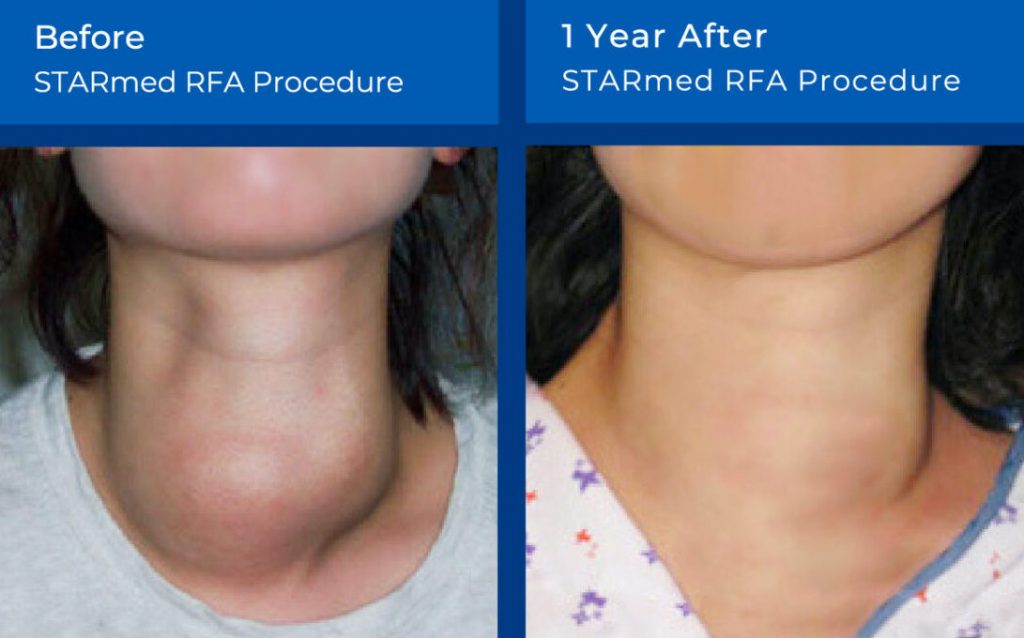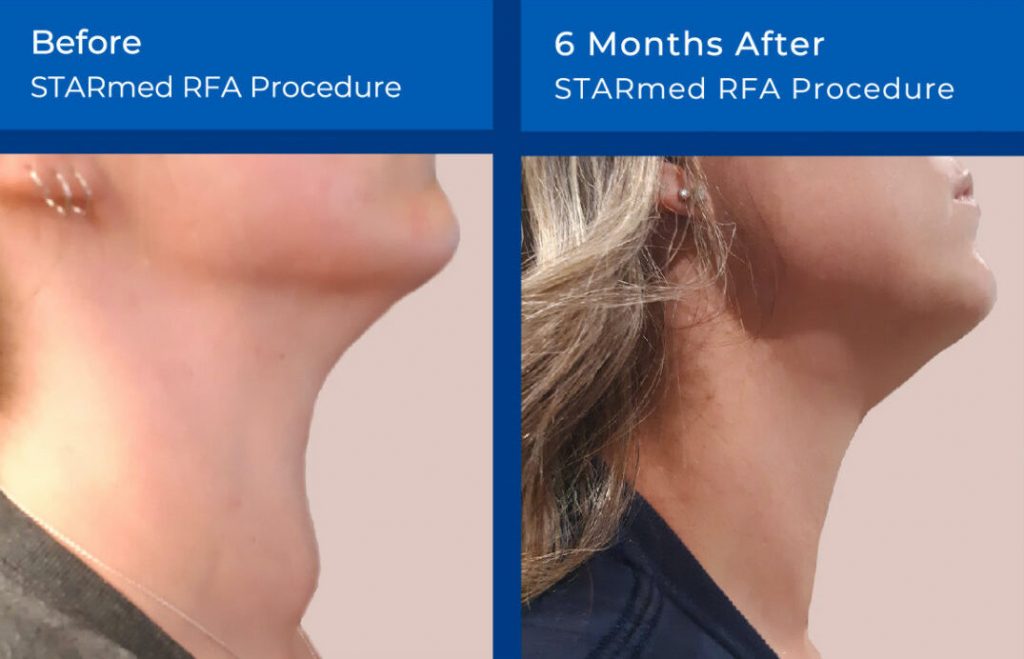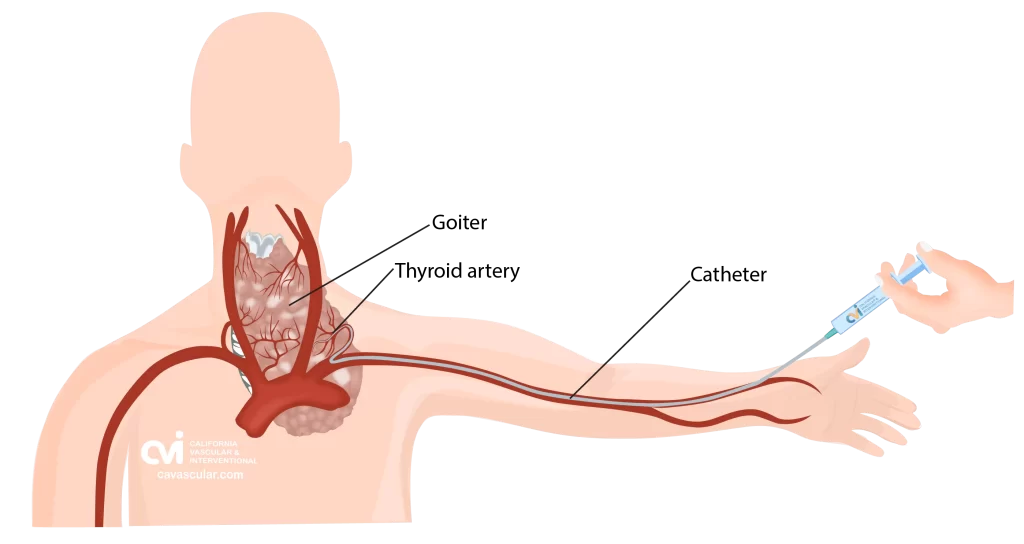Thyroid nodules and goiters are common thyroid disorders, and various treatment modalities have been explored to address them. There are non-surgical options called thyroid radiofrequency ablation (RFA) for thyroid nodules and embolization for thyroid goiters. What is the difference and what is best?
Thyroid Radiofrequency Ablation (RFA):
Tissue ablation is not new. Ablation is the use of some form of energy to destroy tissue. There are many ablation modalities including microwave, laser, radiofrequency (RFA), electrotherapy, and cryoablation (freezing). The modalities are used to treat cancer and benign issues throughout the body. The modality of choice depends on the organ and underlying issue being treated. Our doctor is one of a few doctors that has experience with a variety of ablation modalities and embolization, including the thyroid gland.
Thyroid RFA - The Procedure:
Thyroid RFA involves the use of radiofrequency waves to heat and ablate thyroid nodules. This minimally invasive technique is gaining attention as an alternative to surgery for benign thyroid nodules. A specialized electrode is inserted into the nodule, and radiofrequency (RFA) energy is applied, causing burning and destruction of the nodule tissue.1 Read more here about the RFA procedure


Thyroid RFA Effectiveness and Outcomes:
Studies suggest that thyroid RFA is effective in reducing the size of benign thyroid nodules, alleviating symptoms, and improving cosmetic concerns. The RFA procedure has been associated with a low complication rate and a high rate of patient satisfaction.2 It is crucial to explore long-term outcomes, and further research is ongoing. Consultation with a thyroid RFA specialist is recommended to determine how this can be successful for your situation.
Advantages of Thyroid RFA
- No major scar
- No stitches
- No anesthesia risks
- No hormone replacement
- No radiation
- No hospital bills
- Outpatient
- Fast recovery
- Spares normal thyroid tissue
- Less risks than surgery
Thyroid Goiter Embolization:
TAE is thyroid artery embolization, which mean blocking blood flow in one more of the blood vessels to the thyroid gland.
Embolization has been around for many decades, and it means the blockage of blood flow to a targeted tissue. This is a non-surgical treatment that many patients undergo for cancer, tumors, bleeding, pain, and other issues. This is an outpatient 1 hour procedure with a high safety profile that is becoming more routine. Our doctor is one of a few doctors that has experience with a variety of embolization and ablation treatments for different organs of the body.
Thyroid Goiter Embolization - The Procedure:
Thyroid goiter embolization is a minimally invasive procedure involving the injection of tiny particles into the blood vessels supplying the enlarged abnormal thyroid tissue. This reduces the blood flow to the thyroid goiter, leading to a reduction in size and associated symptoms.3 Read more here about the TAE procedure.

Thyroid Goiter Embolization - Effectiveness and Outcomes:
Studies assessing the effectiveness of thyroid goiter embolization have shown promising results in terms of size reduction and symptom improvement.4 The TAE procedure is generally considered safe, with few reported complications. However, more research is needed to establish its long-term efficacy. Consultation with an embolization specialist is recommended to determine how this can be successful for your situation.
Advantages of Thyroid Artery Embolization
- No major scar
- No stitches
- No anesthesia risks
- No hormone replacement
- No internal cutting or bleeding
- Outpatient
- Fast recovery
- Saves your thyroid gland
- Less risks than surgery
Request an Appointment
Please note that although we strive to protect and secure our online communications, and use the security measures detailed in our Privacy Policy to protect your information, no data transmitted over the Internet can be guaranteed to be completely secure and no security measures are perfect or impenetrable. If you would like to transmit sensitive information to us, please contact us, without including the sensitive information, to arrange a more secure means of communication. By submitting this form you consent to receive text messages from CVI at the number provided. Msg & data rates may apply. Msg frequency varies. Unsubscribe at any time by replying STOP.
Thyroid RFA vs Embolization: What is the Difference?
Thyroid RFA primarily targets benign nodules, providing a therapeutic alternative to surgery. Thyroid goiter embolization is aimed at reducing the size of an overall enlarged thyroid gland, offering a potential alternative for symptomatic goiters to surgery. In other words, the RFA procedure targets a precise treatment to a small area while the embolization procedure targets a larger regional area supplied by blood flow.
Procedural Differences:
The mechanisms of action differ significantly. RFA relies on heat to destroy nodule tissue, while embolization involves reducing blood supply to the thyroid tissue. Both lead to the body resorbing these inactive tissues which then result in shrinkage.5
Patient Selection:
The selection of patients for each procedure depends on the underlying thyroid condition. RFA is typically best for patients with a single benign thyroid nodule. In contrast, embolization is best for patients that have numerous nodules, a very large nodule or a large goiter.6
Thyroid RFA vs Embolization: What is the Best for Me?
This is something that can only be answered by our physician that has extensive experience with different ablation and embolization procedures. Some patients may benefit from just an RFA procedure and that is all they will require. However others may require too many RFAs procedure to have a successful outcome or there may be a high bleeding risk that can be mitigated by embolization. Some patients would have better results and less risk with an embolization first approach before an RFA procedure. Some patients may only need an embolization.
Both thyroid RFA for nodules and embolization for goiters represent emerging alternatives to traditional surgical interventions. The choice between the two depends on the specific thyroid condition, patient characteristics, and treatment goals. While RFA focuses on nodules, embolization is tailored for goiters, reflecting the need for personalized approaches in managing thyroid disorders.
Why California Thyroid Center?
Our physician is one of only a few specialists with a background in both thyroid RFA ablation and the embolization technique. He will evaluate you and decide which treatment option will suit you best. Sometimes a combination approach is necessary to save the thyroid gland.
Our center specializes in embolizations, and our staff is uniquely trained to care for these types of procedures, from the pre-op to the post-op period. Our specialist performs embolization for not only the thyroid but also in other higher risk and complex organs, such as the uterus, kidney, liver, prostate, lung and others. Patients are often surprised how quick and simple the TAE procedure was for them, but this comes at the experience of our specialist who performs a variety of complex embolizations safely. This diversity of experience has resulted in our specialist to treat complex cases safely and effectively.
Our specialist continually keeps up with the research to make sure that he brings the best and newest technology to our center. We are also always collecting feedback from patients and modifying how we provide care so that patients have the best level of experience.
Contact Us Today
Request an appointment to meet with our RFA specialist who will review your imaging, labs and history to determine if you are a good candidate for the procedure, and the outcomes you can expect. Each person is an individual and should discuss the potential risks and benefits of thyroid RFA with our doctor to decide if this is the best option.
Appointments are available via an online video telehealth platform or in person in Los Angeles, California. Why should you choose us? Read here.

- Na DG, Lee JH, Jung SL, et al. Radiofrequency ablation of benign thyroid nodules and recurrent thyroid cancers: consensus statement and recommendations. Korean J Radiol. 2012;13(2):117-125.
- Ha EJ, Baek JH, Lee JH. Moving-shot versus fixed electrode techniques for radiofrequency ablation: comparison in an ex vivo bovine liver tissue model. Korean J Radiol. 2015;16(2):352-358.
- Dhanasekar G, Kuo YH, Wu SY, et al. Thyroid artery embolization in the treatment of symptomatic thyroiditis. J Vasc Interv Radiol. 2019;30(9):1395-1401.
- Russell J, Nikolaidis P. Thyroid Artery Embolization for the Treatment of Benign Hyperfunctioning or Enlarged Thyroid Glands. Semin Intervent Radiol. 2020;37(4):408-415.
- Papini E, Monpeyssen H, Frasoldati A, Hegedus L. 2020 European Thyroid Association Clinical Practice Guideline for the Use of Image-Guided Ablation in Benign Thyroid Nodules. Eur Thyroid J. 2020;9(4):173-185.
- Jo K, Yoo WS, Park I, et al. A novel endoscopic thyroidectomy: transoral periosteal tunnel approach. Surg Endosc. 2017;31(8):3235-3240.
The above information explains what is involved and the possible risks. It is not meant to be a substitute for informed discussion between you and your doctor but can act as a starting point for such a discussion.









